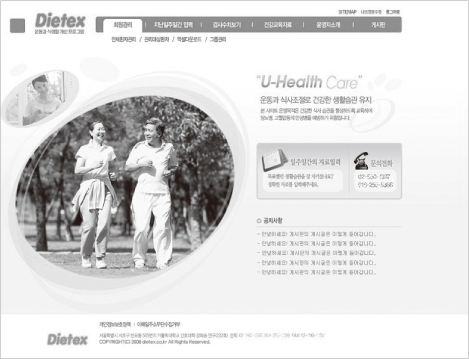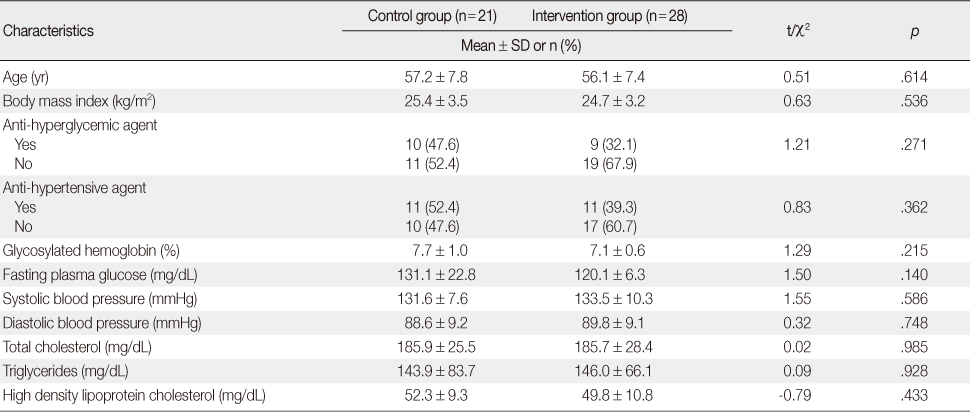Articles
- Page Path
- HOME > J Korean Acad Nurs > Volume 41(5); 2011 > Article
-
Original Article
- Effects of Web-based Health Education on Blood Glucose and Blood Pressure Improvement in Postmenopausal Women with Impaired Fasting Blood Glucose
- Jeong-Ah Oh, Hee-Seung Kim, Min-Jeong Park, Hye-Sun Shim
-
Journal of Korean Academy of Nursing 2011;41(5):724-731.
DOI: https://doi.org/10.4040/jkan.2011.41.5.724
Published online: October 31, 2011
1Team Manager, The Catholic Institute of Ubiquitous Health Care, The Catholic University of Korea, Seoul, Korea.
2Professor, College of Nursing, The Catholic University of Korea, Seoul, Korea.
3Research Fellow, National Health Insurance Corporation, Health Insurance Policy Research Institute, Seoul, Korea.
4Research Instructor, CHA University, Seongnam, Korea.
- Address reprint requests to: Kim, Hee-Seung. College of Nursing, The Catholic University of Korea, 505 Banpo-dong, Secho-gu, Seoul 137-701, Korea. Tel: +82.18-255-5386, Fax: +82.2-2258-7772, hees@catholic.ac.kr
© 2011 Korean Society of Nursing Science
Abstract
-
Purpose
- The purpose of this study was to investigate the effectiveness of an educational intervention that used both cellular phones and the Internet to provide a short messaging service (SMS) relating to blood glucose, blood pressure, and serum lipid levels in postmenopausal women with impaired fasting glucose (IFG).
-
Methods
- Twenty-eight postmenopausal women were assigned to an intervention group and twenty-one postmenopausal women to a control group. The intervention was provided for 12 weeks. Patients in the intervention group were asked to access a web site by using a cellular phone or to use the Internet directly and input their blood glucose and blood pressure levels weekly. Participants were sent the optimal recommendations weekly by both cellular phone and Internet.
-
Results
- The intervention group had a mean decrease in systolic blood pressure (SBP) level of 8.1 mmHg but changes for the control group were not significant. There was a significant mean change in diastolic blood pressure (DBP) level for the intervention group (-7.7 mmHg). The mean change in the control group was not significant.
-
Conclusion
- This educational intervention using the Internet and a SMS by cellular phone improved levels of SBP and DBP in postmenopausal women with IFG.
*The authors wish to acknowledge the financial support of the Catholic Medical Center Research Foundation made to this program in 2008.
- 1. Avignon A, Radauceanu A, Monnier L. Nonfasting plasma glucose is a better marker of diabetic control than fasting plasma glucose in type 2 diabetes. Diabetes Care. 1997;20:1822–1826.ArticlePubMedPDF
- 2. Fleischmann EH, Friedrich A, Danzer E, Gallert K, Walter H, Schmieder RE. Intensive training of patients with hypertension is effective in modifying lifestyle risk factors. Journal of Human Hypertension. 2004;18:127–131. doi: 10.1038/sj.jhh.1001648.ArticlePubMedPDF
- 3. Folsom AR, Szklo M, Stevens J, Liao F, Smith R, Eckfeldt JH. A prospective study of coronary heart disease in relation to fasting insulin, glucose, and diabetes: The Atherosclerosis Risk in Communities (ARIC) study. Diabetes Care. 1997;20:935–942.ArticlePubMedPDF
- 4. Isomaa B, Almgren P, Tuomi T, Forsen B, Lahti K, Nissen M, et al. Cardiovascular morbidity and mortality associated with the metabolic syndrome. Diabetes Care. 2001;24:683–689. doi: 10.2337/diacare.24.4.683.ArticlePubMedPDF
- 5. Jeong IK, Moon MK, Kim SW, Park YJ, Kim SY, Park DJ, et al. Comparison of clinical characteristics of impaired fasting glucose with impaired glucose tolerance in Yonchon county. The Journal of Korean Diabetes Association. 2000;24:71–77.
- 6. Joint National Committee. The sixth report of the Joint National Committee on prevention, detection, evaluation, and treatment of high blood pressure. Archives of Internal Medicine. 1997;157:2413–2448.ArticlePubMed
- 7. Kim CS, Jeong EK, Park JA, Cho MH, Nam JS, Kim HJ, et al. Prevalence of diabetes mellitus (fasting plasma glucose by the ADA criteria) and impaired fasting glucose according to anthropometric characteristics and dietary habits - 1998 National Health and Nutrition Survey. Diabetes & Metabolism Journal. 2005;29:151–166.
- 8. Kim HM, Park J, Ryu SY, Kim JO. The effect of menopause on the metabolic syndrome among Korean women. Diabetes Care. 2007;30:701–706. doi: 10.2337/dc06-1400.ArticlePubMedPDF
- 9. Kim HS. Effects of web-based diabetic education in obese diabetic patients. Journal of Korean Academy of Nursing. 2005;35:924–930.ArticlePubMedPDF
- 10. Kim HS, Oh JA. Comparison of the metabolic syndrome risk factor prevalence in the age of forties and fifties women. Journal of Korean Academy of Nursing. 2007;37:453–458.PubMed
- 11. Kim MH, Kim MK, Choi BY, Shin YJ. Prevalence of metabolic syndrome and its association with cardiovascular diseases in Korea. Journal of Korean Medical Science. 2004;19:195–201. doi: 10.3346/jkms.2004.19.2.195.PubMedPMC
- 12. Kim SM. Postmenopausal obesity. Journal of Korean Society for the Study of Obesity. 2001;10:217–226.
- 13. Koh JH, Lee MY, Nam SM, Sung JK, Jung PM, Noh JK, et al. Relationship between menopausal status and metabolic syndrome components in Korean women. Korean Diabetes Journal. 2008;32:243–251. doi: 10.4093/kdj.2008.32.3.243.Article
- 14. Lee HJ, Kwon HS, Park YM, Chun HN, Choi YH, Ko SH, et al. Waist circumference as a risk factor for metabolic syndrome in Korean adult: Evaluation from 5 different criteria of metabolic syndrome. The Journal of Korean Diabetes Association. 2005;29:48–56.
- 15. Lee SW, Kim MR, Kwon DJ, Kim JH, Kim JH, You OU. Relationship between metabolic syndrome and bone mineral density in the postmenopausal women. Korean Journal of Obstetrics and Gynecology. 2009;52:835–842.
- 16. Lopez-Candales A. Metabolic syndrome X: A comprehensive review of the pathophysiology and recommended therapy. Journal of Medicine. 2001;32:283–300.PubMed
- 17. Park MJ, Kim HS, Kim KS. Cellular phone and internet-based individual intervention on blood pressure and obesity in obese patients with hypertension. International Journal of Medical Informatics. 2009;78:704–710. doi: 10.1016/j.ijmedinf.2009.06.004.ArticlePubMed
- 18. Park MJ, Kim HS. Mobile phone and internet intervention on waist circumference and blood pressure in post-menopausal women with abdominal obesity. International Journal of Medical Informatics. in press.
- 19. Piette JD, Weinberger M, Kraemer FB, McPhee SJ. Impact of automated calls with nurse follow-up on diabetes treatment outcomes in a department of Veterans Affairs Health Care System: A randomized controlled trial. Diabetes Care. 2001;24:202–208. doi: 10.2337/diacare.24.2.202.ArticlePubMed
- 20. Rudd P, Miller NH, Kaufman J, Kraemer HC, Bandura A, Greenwald G, et al. Nurse management for hypertension: A systems approach. American Journal of Hypertension. 2004;17:921–927. doi: 10.1016/j.amjhyper.2004.06.006.ArticlePubMed
- 21. Underbakke G, McBride PE, Spencer E. Web-based resources for medical nutrition education. The American Journal of Clinical Nutrition. 2006;83:951S–955S.ArticlePubMed
- 22. Wedisinghe L, Perera M. Diabetes and the menopause. Maturitas. 2009;63:200–203. doi: 10.1016/j.maturitas.2009.04.005.ArticlePubMed
- 23. Welty FK, Nasca MM, Lew NS, Gregoire S, Ruan Y. Effect of onsite dietitian counseling on weight loss and lipid levels in an outpatient physician office. The American Journal of Cardiology. 2007;100:73–75. doi: 10.1016/j.amjcard.2007.02.056.ArticlePubMedPMC
- 24. Yu SJ, Song MS, Lee YJ. The effects of self-efficacy promotion and education program on self-efficacy, self-care behavior, and blood pressure for elderly hypertensives. Journal of Korean Academy of Adult Nursing. 2001;13:108–122.
- 25. Zimmet P, Alberti G. The IDF definition: Why we need a global consensus. Diabetes Voice. 2006;51:11–14.
REFERENCES
Figure & Data
REFERENCES
Citations

- Development of Pre-discharge Group Education Program for Liver Transplant Patients
Ji Seon Yun, Kyung Choon Lim, Jae Sim Jeong, Hea Seon Ha, Jung Ja Hong, Soon Haeng Lee, Lee Young Kim, Yeon Hee Kim, Shin Hwang
Korean Journal of Transplantation.2017; 31(1): 34. CrossRef - Autonomy‐supportive, Web‐based lifestyle modification for cardiometabolic risk in postmenopausal women: Randomized trial
Hye‐Ryoung Kim, Hee‐Seung Kim
Nursing & Health Sciences.2017; 19(4): 509. CrossRef - Web-based interventions for menopause: A systematic integrated literature review
Eun-Ok Im, Yaelim Lee, Eunice Chee, Wonshik Chee
Maturitas.2017; 95: 24. CrossRef - Does nutritional counseling in telemedicine improve treatment outcomes for diabetes? A systematic review and meta-analysis of results from 92 studies
Dejun Su, Chelsea McBride, Junmin Zhou, Megan S Kelley
Journal of Telemedicine and Telecare.2016; 22(6): 333. CrossRef - The influence of intensive lifestyle intervention on patients with isolated impaired fasting glucose: a meta‐analysis
Xiu‐Juan Yang, Shu‐Fang Zou, Yong Xu, Yi Li, Shan‐Shan Yang
Journal of Advanced Nursing.2016; 72(11): 2587. CrossRef - The development of a mobile u-Health program and evaluation for self-diet management for diabetic patients
Yun Ahn, Jeahurn Bae, Hee-Seon Kim
Nutrition Research and Practice.2016; 10(3): 342. CrossRef - Factors Affecting Nurses' Web-based Learning Achievement in Schoolwork
Young Im Kim, Tae Yoon Kim
Korean Journal of Occupational Health Nursing.2013; 22(1): 57. CrossRef - Evaluation of mobile phone and Internet intervention on waist circumference and blood pressure in post-menopausal women with abdominal obesity
Min-Jeong Park, Hee-Seung Kim
International Journal of Medical Informatics.2012; 81(6): 388. CrossRef

Figure 1
Demographic and Clinical Characteristics of the Participants
Effect of the Intervention on Plasma Glucose and Blood Pressure Levels
a,bsignificantly difference (p<.05).
Effect of the Intervention on Serum Lipids Levels
asignificantly difference (p<.05).
a,bsignificantly difference (
asignificantly difference (
 KSNS
KSNS
 E-SUBMISSION
E-SUBMISSION




 Cite
Cite

